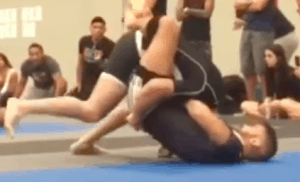Chokes are an effective way of winning a grappling match and one of the best and most natural ways to choke someone is by placing them in a guillotine choke.
The guillotine choke hold is a bio-mechanically natural choke, it is easy to administer and even easier to learn. It is a simple submission that is a high percentage finisher when done correctly, it has been used successfully in many different grappling arts as well as in both MMA and self-defense scenarios.
There are many variations of the guillotine choke and it can be found in many grappling based martial arts such as Brazilian Jiu-jitsu, Japanese Jujutsu, Catch Wrestling, MMA and Judo – known as “mae hadaka jime” in Japanese.
One of the best advantages about the guillotine is this highly effective choke that can be done from both standing and when on the ground. When performing the guillotine choke on the ground, the guillotine can be administered from several positions such as the guard, side and mount and this makes it a highly versatile choke as it can be performed both from a top and bottom position when on the ground.

It is not uncommon to see a guillotine choke applied as a counter move when an opponent escapes from a submission such as a kimura, is in the process of working a positional escape such as a side control escape or when an opponent makes a mistake not protecting their neck during a scramble.
How Does a Guillotine Choke Work?
The guillotine choke works by cutting off an opponent’s air supply by applying compression to their trachea. In certain cases, the Guillotine can be modified to be a blood choke where blood supply is cut off to the brain.
Depending where the opponent’s head is and what the positions of your arm and body, the guillotine can also have a bot of a neck crank effect.
These choke attributes make the guillotine a highly effective submission as once it is properly locked on, there is very little chance to escape.
Types of Guillotine Chokes
There are many variations to the guillotine, each variation is still a highly effective version of this effective submission. Generally the variations are based upon the type of grip, the angle the submission is performed at and the position that you are in when placing the choke on the opponent.
Here are some of the best guillotine choke variations that you should add to your grappling portfolio.
Standing Guillotine Choke
This is the bread and butter of guillotine chokes and very easy to get anytime an opponent exposes their neck. It can be done when an opponent shoots or commonly off of a snap down when clinch fighting. The choke then can be finished standing or by jumping to guard and finishing from there.
The main detail when snapping an opponent into the guillotine, you must always snap the opponent into the opposite side of your main snapping arm, meaning if you snap down the opponent’s head with your right arm, the head goes to your left side so the left arm can choke. This is to avoid the opponent easily taking your back.
Guillotine Choke From The Guard
This version of the guillotine is generally the first guillotine taught in any grappling martial art that has submissions. It is highly effective, simple and easy to apply. The guillotine choke from the guard is done from full guard when you are on the bottom, when the opponent’s posture is low and the neck is exposed, you simply perform a crunch to grab the opponent’s neck, wrap your arm around the opponents neck where your radial bone of your wrist is under your opponent’s neck, grab the hand that is under the neck with your other hand and move the hand upward in a guillotine motion, while squeezing and using your legs to lock the opponent and preventing them from moving and move slightly backward thus placing immense pressure on the opponent’s throat and neck.
Arm-in Guillotine
The version of the guillotine is very similar to the classic guillotine, the main difference is that when going to wrap your arms around the neck, you wrap around one of the opponent’s arms as well. The main difference is that to finish you want to turn a bit sideways once you have secured the opponent’s neck and then move backwards in a slight sliding motion while squeezing. Generally the arm-in version of the guillotine is better to use when you are in closed guard.
High Elbow Guillotine
The high elbow version of the guillotine works a bit differently than other guillotine chokes as it is a blood choke and not an air choke, this is due to the elbow placement around the neck that cuts off blood supply to both carotid arteries in the opponent’s neck. This version of the guillotine is somewhat similar to the marcelotine in terms of the secondary arm (the hand that is not around the opponent’s neck) and hand position as well as movement of the actual submission. It is effective as it prevents the opponent from going to your weak side and thus keeps you more safe against escapes.
Marcelotine
A highly effective guillotine made famous by the one and only Marcelo Garcia, this version of the choke can be done from many different positions.
It is very similar to the high elbow guillotine is a very high percentage due to the fact that the secondary hand’s forearm is pressed into the opponent’s shoulder thus preventing them from stacking and rolling out of the choke, this allows you to better control the opponent’s distance and not let them get too close to you thus making it much harder for them to escape.
One arm guillotine
A common guillotine to see in MMA, the one arm guillotine is commonly done from the top position such as top half-guard and mount although it can be done from the guard. The one arm guillotine is not as a high percentage guillotine as other guillotines as it is easier to escape than other types of guillotine chokes. One of the main keys to the one armed guillotine is to make sure you place your choking hand on your chest and finish with a slight sidewards pressure when crunching backwards.
Ten Finger Guillotine
One of the most painful guillotine chokes is the ten finger guillotine, this is due to the fact that your grip on the opponent trachea places the thumb and knuckles directly on the trachea itself. A very important detail is if you can, try to keep your chest over their head when performing this type of guillotine. This type of guillotine is great as a counter to when an opponent shoots and you are on your knees and generally leads to very quick taps.
Five Finger Guillotine
Very similar to the one arm guillotine but the difference is in the grip on the neck, generally the 5 finger guillotine choke is done when you achieve a chin strap, one this is done is it easy to get the top of the thumb and knuckles into the opponent’s throat and thus achieving a painful choke on the trachea.
Power Guillotine
An extremely powerful guillotine choke, the power guillotine is done when you get a very deep guillotine grip that is similar to high elbow guillotine but in this case you press the choking hand hard into the neck thus creating more power in the choke. There are several ways to perform the power guillotine.
Pretzel Grip Guillotine
A very unorthodox type of guillotine, the pretzel grip guillotine is made off of a grip called the pretzel grip which has the outside of the wrist choking instead of the inside of the wrist.
When to Use The Guillotine Choke
Once you understand the mechanics and setups of the guillotine you will see it can be done from any position.
The guillotine is a very easy choke to attain as there are many setups and situations where the choke can be applied such as when standing with an opponent, the guillotine can be applied off a collar tie and snapdown as well as when an opponent shoots for a double leg or outside single leg/high crotch, when on the ground, the guillotine is everywhere, especially anytime the opponent is in front of you and looking downwards or holding their neck low and forward as well as the guillotine can be hit off of a sprawl and also off most types of scrambles where the opponent is sloppy in protecting their neck on a takedown.
In Conclusion
The guillotine choke is a staple submission of any grappling martial art, it is a high percentage submission, it is simple to apply and anyone can learn how to do a guillotine choke.
We see it being used all the time in mixed martial arts and it is so effective that even a beginner can choke out a grappling expert if the choke is applied correctly. The guillotine is ever so rightly named as once caught in this devastating choke, your time is done.




